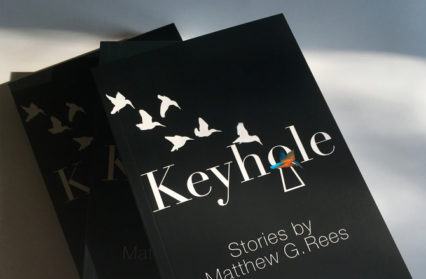Carolyn Percy reviews the debut collection of short stories from Matthew G. Rees, Keyhole, the latest release from innovative Welsh indie publishers, Three Imposters.
A girl who can’t go outside in the sun watches the world through a keyhole. What does she see? A man returning to the place where he grew up to find it haunted by the past; but who is it that’s really haunted, place or man? A woman, her young son and a strange family made of shells. A well that promises to be a family’s salvation during a drought, but whose promise may turn out to be poison. Or a child who’s fascinated by the horses that live around his small mining village. What does she see? All this and more…
The late 19th – early 20th century Welsh author Arthur Machen (the pen-name of Arthur Llewellyn Jones), who is best known for his supernatural, fantasy, and horror fiction – and whose horror novel The Three Imposters (or The Transmutations) the Newport-based independent press who have published Keyhole is named after – was one of many who spoke of a certainty of our co-existence with another world, a world of ancient forces and dark, peculiar things, separated from ours by only the thinnest of veils. And this can definitely be seen in the stories in Keyhole, Matthew G. Rees’s debut short story collection. Rees “grew up in a Welsh family in the border country between England and Wales known as the Marches.” Coincidentally, a liminal quality is the collection’s defining trait. Though the characters and events in the stories are often strange or bizarre, the settings are realistic: rural farms and villages, a house by the sea, a guesthouse, disused industrial landscapes etc. But they are often isolated, in-between places, and therefore easy to present or utilise in a way that highlights their eeriness and adds to the stories’ sense of the uncanny, in a way comparable to or reminiscent of Roald Dahl’s Tales of the Unexpected.
The otherworldliness/eeriness is typically presented/highlighted narratively in one of three ways. Firstly, through plot. For example, the title story, ‘Keyhole’, starts out by telling us of Bronte Vaughan, the girl whose condition prevents her from going outside and how she observes the outside world through keyholes and through a bronze telescope. Then the point of view switches to that of Theaxton, a resident of the town where Bronte’s home is located, and who is returning home, in part in hopes of seeing Bronte again. Things become increasingly strange as the present and past seems to blend together, before returning to the image of an eye watching through a keyhole, implying that Theaxton, and the town, are being observed like a specimen in a petri dish.
Secondly, through character. The narrator in ‘The Service at Plas Trew’, for instance, starts out genial, but his geniality becomes unnerving when he reveals disturbing details in the same manner, including how he just casually took over from the owner of the previous hotel/boarding house he was at after her stroke.
And lastly, through setting. ‘Rain’ is set on an isolated farmstead that a drought renders increasingly barren. The narrator’s father finds a well but the water kills the animals who drink it and makes the grown-ups ill. The parents had taken their children to the farm as a promise to get away from the corrupting status quo of society, only for that promise to turn to literal poison, and the increasingly inhospitableness of the landscape serves to amplify the atmosphere.
This is all, of course, enhanced by beautiful writing throughout. Take this from the opening passages of ‘Keyhole’ for instance:
Bronte Vaughan had a condition that meant she had to be kept from the light. In order that her shuttered world was not entirely without illumination her mother presented her with a Kingfisher… In time her mother… gave Bronte another and another of the birds… The birds swirled in shoals around young Bronte’s white hair and head… her mother would usher the kingfishers, carouselling around her in a sapphire-and-amber whirl, from one room to the next until she and they had reached the conservatory of citrus trees that ran along the manor’s southerly side. There she would throw open its French windows enabling the birds to issue forth in a wondrous fusillade over the reeded moat that teemed with small fish and was populated with water beetles, springtails and other bugs, and danced over by the most lovely and delicate damsel flies in bright bodices of blues and yellows and reds.
Keyhole is Rees’s debut short story collection, (having previously had fiction published in various publications, and a fantasy-comedy play – Dragonfly), and it is a wonderfully accomplished one, both generally and within the tradition/genre of strange fiction, demonstrating his skill with the short story format. If he were ever in the future to try his hand at a full-length novel, the result would undoubtedly be one worth investigating.
Keyhole by Matthew G. Rees is available now from Three Imposters.
Carolyn Percy is a regular contributor to Wales Arts Review.











